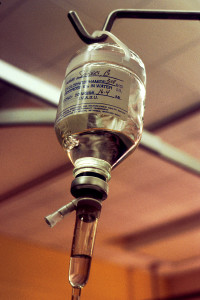 The shortage of pharmaceutical drugs is a serious problem in the US. The number of drugs in short supply has tripled since 2007. In an article in The New York Times, Sabrina Tavernise reports that the number of drugs in short supply in 2012 was 456.
The shortage of pharmaceutical drugs is a serious problem in the US. The number of drugs in short supply has tripled since 2007. In an article in The New York Times, Sabrina Tavernise reports that the number of drugs in short supply in 2012 was 456.
The types of drugs affected cover a very wide range and include such things as cancer drugs and nitroglycerine used in heart surgeries. The situation is quite disruptive for hospitals, doctors (especially oncologists), and patients.
IV fluid shortage threatens patient care
This year, in addition to drug shortages, there is a nationwide shortage of IV fluid. Intravenous therapy is essential for treating dehydration and electrolyte imbalances, for blood transfusions, and for delivering medications such as those used in chemotherapy. IV fluid is a hospital staple.
A recent JAMA article quotes Erin R. Fox, director of the Drug Information Service at the University of Utah in Salt Lake City: (emphasis added in the following quotations)
“It’s maddeningly frustrating that we don’t have these basics.” … Fox said that although shortages of drugs, particularly sterile injectables, have become common in recent years, it is unheard-of to have a shortage of such a basic supply. …
“Why is the supply chain so fragile that it creates a national crisis? asked Fox. …
“Physicians, nurses, and pharmacists are working together to minimize the harm to patients, but it is really a challenge,” she said.
Vijay Paudel, an oncologist at Coastal Cancer Center in Myrtle Beach, South Carolina, commented on the high pressure tactics suppliers use to take advantage of the shortage.
Some suppliers that have saline are putting pressure on practices to sign a contract to obtain all of their supplies for a year or to agree to buy other products from them, according to Paudel.
“Some suppliers will try to hardball you into some kind of contract,” Paudel said. “We are talking about people’s lives; this is not a cell phone contract.”
Why the shortages?
The reasons for the shortages are not exactly clear. When asked about the causes in a PBS NewsHour segment, New York Times journalist Tavernise replied:
The producers themselves are a bit secretive. They say it’s a trade secret to tell the world exactly what’s happening to cause the shortage so they don’t need to detail the reason.
A common explanation for many of the shortages is that manufacturers have insufficient motivation due to low profit margins.
[S]ometimes what happens is a [production] line goes down, something breaks down and a company, a producer looks at the margins and the economics and says ‘well, you know it’s not really worth the margins we’re getting on this drug in continuing the line – in putting the money in to fix it.’ So they let the drug go into shortage. And even if people need it – say its nitroglycerine which is critical in heart surgery – they just don’t produce it. And, at the end of the day the FDA can encourage producers to keep going but doesn’t really have the power to force them to do that.
From the Times article:
Manufacturers, motivated by profit, will often choose to increase production of higher profit drugs on their busy factory floors, even if that means risking a shortage of less profitable drugs.
When the profit motive influences medical decisions
The very next JAMA article, after the one on IV fluids, also illustrates the unfortunate side effects of for-profit medicine. It describes how for-profit clinics in Africa fail to use oral rehydration therapy for children with diarrhea. “[T]hey are more likely than large public hospitals to prescribe expensive treatments instead” — treatments such as antibiotics, that may not be necessary and that cost more. Oral rehydration therapy — a highly effective treatment for children suffering from a diarrheal illness — would only cost less than fifty cents per treatment. Not much room for profit there.
Related posts:
Pharma finds creative new ways to be reprehensible
Profit-driven medicine: Satisfying patients at the expense of their health
Are the most heavily marketed drugs the least beneficial?
Why medicine is not a science and health care is not health
Image source: Wikipedia
References:
Bridget M. Kuehn, Nationwide IV Fluid Shortage Threatens Care, JAMA, May 14, 2014, Vol 311, No 18, pp 1843-1844 (paywall)
Bridget M. Kuehn, For-Profit African Clinics Underuse Oral Rehydration Therapy for Diarrhea, JAMA, May 14, 2014, Vol 311, No 18, p 1845
Sabrina Tavernise, Drug Shortages Continue to Vex Doctors, The New York Times, February 10, 2014
Hari Sreenivasan, What’s behind the nation’s prescription drug shortage?, PBS NewsHour, February 16, 2014


Sorry, comments are closed for this post.